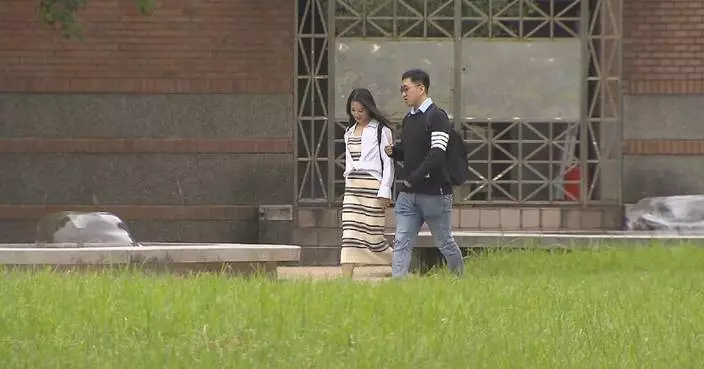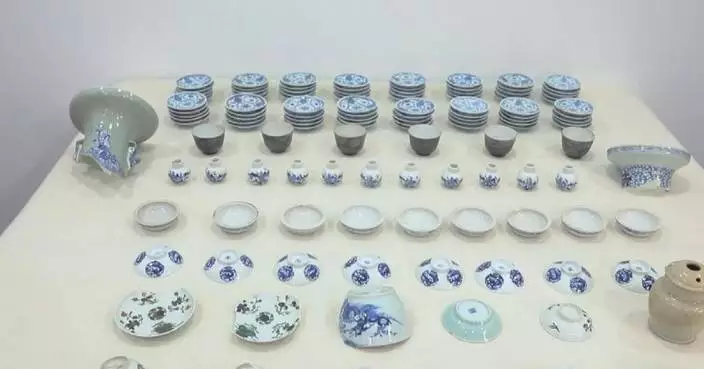A Chinese children's choir arrived in Paris on Saturday, starting its five-day tour of cultural exchanges where it will perform to mark the 60th anniversary of the establishment of China-France diplomatic relationship.
Coming from Wuzhishan City, south China's Hainan Province, the Children's Choir of Shuiman Center School is comprised of children from ethnic groups of Li and Miao. Many members of the choir expressed their excitement of the tour and their desire to promote their ethnic culture in France and cultural exchanges between Chinese and French children.
"I think I can make many foreign friends here through this tour. I love the choir very much, which brings us to learn a lot of knowledge," said Wang Ruhan, a member of the children's choir.
"Through this trip to Paris, I can make friends with many French pals. And I can't wait to row on the Seine River and have a taste of the artisan bread," said Wang Xinghe, another member of the choir.
After their arrival in Paris, the children attended an orchestra concert.
"I love this concert. It was wonderful and sounded nice. I think I can make quite a lot of French friends," said Gao Mingyang, a member with the children's choir.
On Sunday, the Chinese children's choir cooperated with the Paris Polysons Choir in a joint performance.
"I am delighted to have the joy of receiving this children's choir who have come to celebrate the 60th anniversary of France-China relations. It was very nice to have them with us," said Elisabeth Trigo, director of the Paris Polysons Choir.

Chinese children choir starts cultural exchange tour in France
Chinese scientists have recently worked together and rebuilt the face of an ancient Chinese ethnic minority emperor via cutting-edge DNA technology.
Emperor Wu of the Xianbei-led Northern Zhou Dynasty (557-581), also known as Yuwen Yong, was an ambitious leader who died at 36. He belonged to the Xianbei nomadic group, which originated from the Mongolian Plateau.
The tomb of the emperor was discovered in 1993 in a village of the city of Xianyang in northwest China's Shaanxi Province. His skull and bones were discovered during an excavation held in 1994 and 1995 at the site of his tomb.
In late March this year, scientists led by the Shaanxi Provincial Institute of Archaeology and the Institute of Archaeological Science of Fudan University managed to decode key features of the emperor and speculate about his cause of death. The emperor might have died from chronic arsenic poisoning due to long-term use of a pellet, which was believed by ancient people to achieve eternal life.
"First, the skeleton can be used to determine age. Second, in terms of age and gender, some pathological research can also be done to see if he had any fractures or other (diseases)," said Zhang Jianlin, a researcher from the Shaanxi Provincial Institute of Archaeology.
Obtaining high-quality genomic data is crucial for restoring the face. Through DNA paleogenomics techniques and optimized DNA extraction, database building and capture methods, more history was revealed.
"First, we have done the shorter fragments enrichment method, which is a DNA extraction method. In addition, we have developed some more sensitive database building method suitable for ancient samples with short fragments. You can regard it as a method to amplify the genetic signal, the extracted DNA. The third is that we have developed a capture method that is more suitable for this kind of highly degraded ancient samples. So we have optimized and improved our approach from three aspects at the same time," said Wen Shaoqing, an associate professor of the Institute of Archaeological Science of Fudan University.
The reconstructed face showed that Yuwen Yong had black hair, yellow skin and brown eyes, while his appearance was typical for people from East or Northeast Asia.
Wen said that with the help of the DNA technology, the accuracy of facial restoration can reach 90 percent.
"As for the accuracy of (facial restoration), the current situation is that if there is a skull as a basis, its accuracy will be relatively high," said Wen.

Scientists rebuild face of ancient emperor using advanced DNA technology










